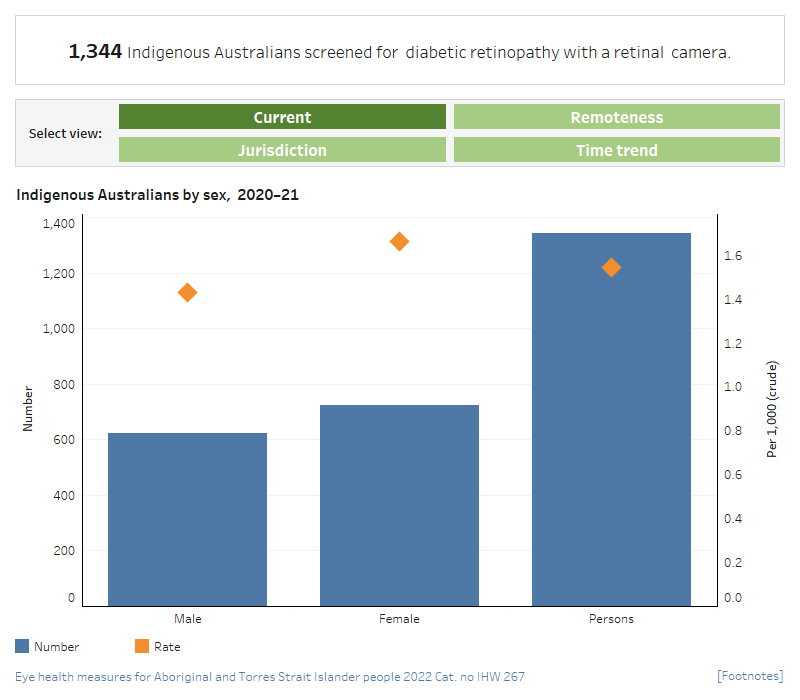Screening for diabetic retinopathy with a retinal camera (MBS data)
Measure 2.3.3: The number of Indigenous Australians who were screened for diabetic retinopathy with a retinal camera, in the 12-month period (MBS data).
Figure 2.3.3: Screening for diabetic retinopathy with a retinal camera (MBS data)
There are 4 separate charts for this measure showing the number and rate of those screened for diabetic retinopathy with a retinal camera.
Number and rate per 1,000 of Indigenous Australians who were screened for diabetic retinopathy with a retinal camera by sex, 2020–21
This dual axis combined vertical bar chart and scatter plot shows the number and rate of Indigenous Australians who were screened for diabetic retinopathy with a retinal camera in 2020–21, by sex. The rate of visual acuity tests was higher for Indigenous females than Indigenous males (1.7 per 1,000 and 1.4 per 1,000, respectively).
Number and rate per 1,000 of Indigenous Australians who were screened for diabetic retinopathy with a retinal camera by region, 2020–21
This dual axis vertical bar chart and scatter plot shows the number and rate of Indigenous Australians diagnosed with diabetes who were screened for diabetic retinopathy with a retinal camera in 2020–21, by region. The rate was highest in Remote areas, 3.7 per 1,000 population and lowest in Major cities, 0.8 per 1,000 population.
Number and rate per 1,000 of Indigenous Australians who were screened for diabetic retinopathy with a retinal camera by jurisdiction, 2020–21
This dual axis combined vertical bar chart and scatter plot shows the number and rate of Indigenous Australians diagnosed with diabetes who were screened for diabetic retinopathy with a retinal camera in 2020–21, by jurisdiction. The rate was highest in Western Australia, 8.9 per 1,000 population and lowest in New South Wales, 0.8 per 1,000 population.
Number of Indigenous Australians who were screened for diabetic retinopathy with a retinal camera by age, 2016–17 to 2020–21
This line graph shows the number of Indigenous Australians who were diagnosed with diabetes who were screened for diabetic retinopathy with a retinal camera from 2016–17 to 2020–21, by age group. The number of eye examinations is highest for those aged 45–59 years across all years and has also risen most steeply for this group, rising from 173 in 2016–17 to 684 in 2018–19, before declining to 539 in 2020–21.

- In 2020–21, an estimated 1,344 (1.5 per 1,000 Indigenous population) Indigenous Australians were screened for diabetic retinopathy with a retinal camera.
- In 2019–20 and 2020–21, the rate of screening tests for diabetic retinopathy with a retinal camera for Indigenous Australians was lowest in Major cities and Inner regional areas (0.8 and 0.6 per 1,000, respectively) and highest in Remote areas (3.7 and 4.4, respectively).


